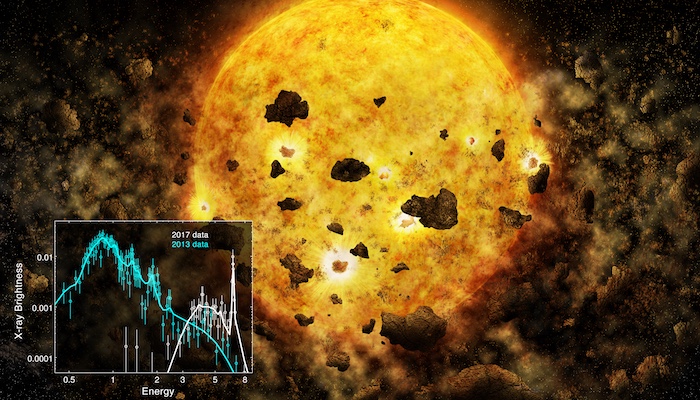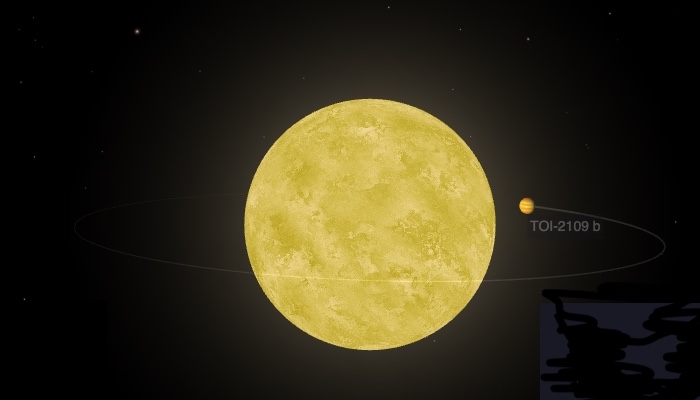A massive planet five times heavier than Jupiter is locked in an astronomical death spiral, completing an orbit around its star in just 16 hours – and Macquarie University researchers have calculated exactly how this astronomical catastrophe will unfold.

Cosmic catastrophe: One of three scenarios for TOI-2109b involves the planet accelerating its death spiral until consumed by its star, similar to this illustrated planetary destruction. Illustration: NASA/CXC/M. Weiss; X-ray spectrum: NASA/CXC/MIT/H. M.Günther
The ultra-hot Jupiter exoplanet TOI-2109b, located 870 light-years from Earth in the Hercules constellation within our Milky Way galaxy, has some extraordinary characteristics making it unique among the thousands of exoplanets discovered so far.
A ‘hot Jupiter’ is a class of high-mass gas-giant planets orbiting so close to their star that they become super-heated; they are rare and make up around two planets in a thousand.
“This is an ultra-hot Jupiter, and orbits much closer to its star than any other hot Jupiter ever discovered,” says Dr Jaime A. Alvarado-Montes, a Macquarie Research Fellow who led the international study published on 15 July in The Astrophysical Journal.
One year on this giant, gaseous planet is an extraordinarily short 16 hours; and with a mass nearly five times that of Jupiter, and almost twice Jupiter's size, TOI-2109b orbits its star at a distance even closer than Mercury’s orbit around our Sun.
“Just to put it into context – Mercury’s mass is almost 6000 times smaller than Jupiter, but it still takes 88 days to orbit our Sun. For a huge gas giant such as TOI-2109b to fully orbit in 16 hours – it tells us that this is a planet located super-close to its star.”
This exoplanet’s extreme proximity to its host star makes it an ideal laboratory for studying ‘orbital decay’ — an event predicted by theory but rarely detected in exoplanet systems.
Theory meets observation
The planet TOI-2109b was first observed in 2021 by another group of astronomers.

Death dance: This artist's illustration shows ultra-hot Jupiter TOI-2109b, five times Jupiter's mass, locked in a 16-hour orbit around its star. Credit: Illustration: NASA Exoplanet Catalog
The Macquarie-led research team breakthrough came from combining archival data from multiple ground-based telescopes with observations from two space-based telescopes: NASA’s TESS mission and the European Space Agency’s CHEOPS satellite. By analysing transit timing data spanning from 2010 to 2024, the team found that subtle changes in the planet's orbit can be detected.
“Using all of the data available for this planet, we were able to predict a small change in its orbit,” Dr Alvarado-Montes says. “Then we verified it with our theory and with our planet evolution models, and our predictions matched the observations. That’s quite exciting.”
The match between theoretical predictions and observational data represents a significant achievement in exoplanet science. Both approaches independently calculated that the planet's orbital period would decrease by at least 10 seconds over the next three years – a tiny but measurable change that confirms the planet may be spiralling towards its star.
Three paths to destruction
The researchers predict orbital decay could lead to three possible scenarios for TOI-2109b's ultimate fate, each offering insights into planetary evolution across different types of solar systems in the cosmos.
This planet and its interesting situation could help us figure out some mysterious astronomical phenomena that so far we really don't have much evidence to explain.
In the first scenario, as the planet approaches the Roche limit – the point where ‘tidal forces’ between planet and star overcome the planet's own gravity – it will be literally torn apart. “The gravitational interactions are so strong that the planet starts being distorted,” Dr Alvarado-Montes explains. “It starts looking more like an elongated doughnut ... the gravity of the planet is no longer able to hold its spherical shape.”
The second possibility is even more dramatic. If orbital decay accelerates, the planet could plunge directly into its star. “The star will absorb it and kill it, of course, in the process – completely burn it, and the planet will disappear,” says Dr Alvarado-Montes.
Such an event would create a detectable flash, similar to or bigger than the one observed in 2020, when a rocky planet was consumed by its host star.
Rocky transformation
The third scenario offers an unexpected twist. The intense stellar radiation could strip away the planet’s gaseous envelope through a process called photoevaporation, leaving only its rocky core.
- Eureka! The global warming maths problem that took 15 years to solve
- Why biology could be the future of computing and engineering
“As the planet gets even closer to the star, all of the gas molecules could start being dissociated, and the planet gets smaller and smaller,” Dr Alvarado-Montes explains.
“And if the planet shrinks quickly enough, then when the planet reaches the position where its Roche limit would have been, it’s not going to be five Jupiter masses anymore, but it will be small enough that the Roche limit moves closer to the star, so it could escape destruction.”
This transformation could convert the gas giant into a large rocky planet, a kind of ‘super-Earth’ that may even be as big as Uranus or Neptune, stabilising in a close orbit and potentially surviving for millions of years.
Benchmark for planetary science
Beyond the individual fate of TOI-2109b – this ultra-hot Jupiter is a benchmark system, providing astronomers with a unique opportunity to test theories of planetary migration and evolution that could apply throughout the universe.

Hot discovery: Dr Jaime Alvarado-Montes, pictured, says the unusual exoplanet TOI-2109b could reveal the violent processes that shape planetary systems across the universe.
"This planet and its interesting situation could help us figure out some mysterious astronomical phenomena that so far we really don't have much evidence to explain," Dr Alvarado-Montes says. "It could tell us the story of many other solar systems."
Based on these observations, he says, some rocky planets in other solar systems might even be the stripped cores of former gas giants — a possibility that would reshape our understanding of planetary formation and evolution.
With continued monitoring over the next three to five years, astronomers will be able to detect the predicted changes in TOI-2109b's orbit, providing real-time observation of a planetary system in its death throes.
This cosmic laboratory promises to unlock secrets about the violent processes that can shape planetary systems across the universe.
Dr Jaime A. Alvarado-Montes is a Macquarie University Research Fellow at Australian Astronomical Optics.
Associate Professor Christian Schwab is from the Macquarie University School of Mathematical and Physical Sciences.



